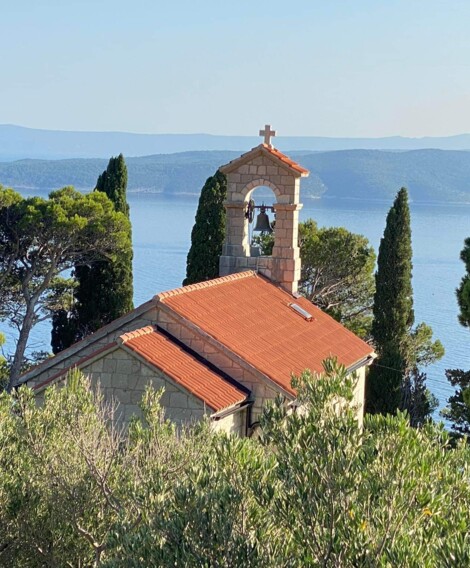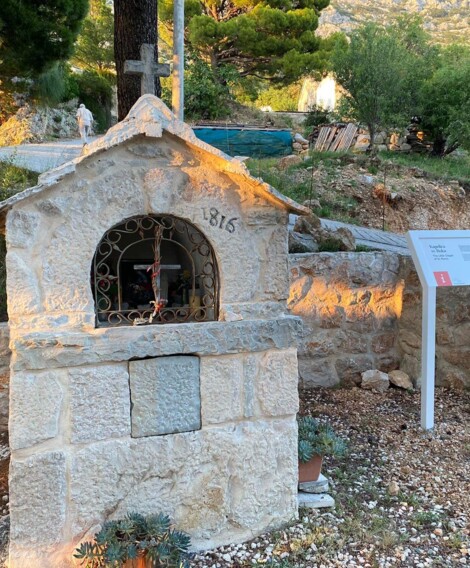Culture
The Church of Our Lady of Mount Carmel
The Church of Our Lady of Carmel, or of Our Lady of Vic - tory, among the pines on a fenced plateau over Soline was built on a cruciform ground plan with the formal features of Baroque classicism. It was put up in 1715 by bishop of Makarska Nikola Bijanković as a memorial to the heroic defence of Sinj against a much larger Turkish army and he dedicated it to the Lady of Victory. In the 19th century it was extended with a bell tower and an open wooden loggia on stone piles. At first the church was owned by the Congregation of the Oratory of St Philip Neri, founded in 1575, but in 1939 the title was transferred to the parish of Brela.
Madonna and Child – Our Lady of Victory, an icon of the 16th century that Zoraida Demori Staničić has convincingly con - nected with the hand of Donato Bizamano, a painter of Greek descent. With his broher Angelo, Donato moved from Crete to Otranto in Puglia in the first half of the 16th century. There they formed a school of painting that had particular traits and was markedly Byzantine in character. We cannot know, how - ever, where the bishop obtained his painting which is solemnly displayed before the church on the feast of Our Lady of Carmel and on the feast of the Assumption; earlier it was borne in a procession.
The bell tower of the church was built on at a later time. It was built in 1833 by master builder Pavao Bertapelle and Antun Bertapelle, son of Pavao deceased, and his uncle, Jure An - drijin Štambuk, with his thirteen year old son Andrija, already a carver’s assistant, as well as Petar Štambuk Andrijin. The foun - dation of the operations of this little dynasty of stone carvers in Dalmatia was laid by the builder Andrija Bertapelle who came from the northern Italian city of Bassano in the 18th century. He soon made himself at home in Vrboska and was Croaticised. With their industriousness, they extended the life of Venetian Baroque in the province, connecting the local tradition of work - ing local stone with the carver’s skill of work in polychrome mar - ble. Having finished the first storey these master craftsmen set off on July 17 in their own gajeta (boat) to their home in Vrbos - ka. Transportation of stone was not at all easy, since the owners as a whole were keen on cramming as much material as they could into a boat. In the Brač bay of Rasovnja by Selce, from which the Štambuks came, they loaded various pieces of stone, channels and parts of windows (varj pezzi di canali di pietre, ed erte per i balconi) and in a light northerly sailed off an hour before midnight across the Hvar Channel, at the insistence of the mas ter builder and gajeta owner, and against the will of all the others. Pavao was awaited in Vrboska by his pregnant wife with four small children, and Antun Bertapelle by his five little children. Two miles from Brač, waves swept over the overloaded boat and in a moment it went to the bottom with its cargo. Jure Štambuk was saved by clinging onto a plank, and Petar Štambuk on the lid of some kind of crate, spending fifteen hours in the sea until he was rescued by fishermen, the brothers Barbarić of the bay of Dubac on Hvar. The unlucky lad Jure Štambuk went down with the boat and they watched master builder Pavao Bertapelle some time longer at the stern, while they could hear Antun Bertapelle for three hours after the sinking, but were unable to help him.
So, when you are in the Church of Our Lady of Carmel, light a candle before the icon of the Madonna in memory of the industrious sculpting and building family of the Bertapellles and of little Jure Štambuk who built the picturesque bell tower that with its final loggia reminds us of the loggia alongside the Dominican church in Stari Grad on Hvar.
On the 300th anniversary of the construction of the church, on 16.07.2015, the grateful inhabitants of Brela raised him a monument located in the churchyard.
The feast day of Our Lady of Mount Carmel is celebrated on 16th July.













